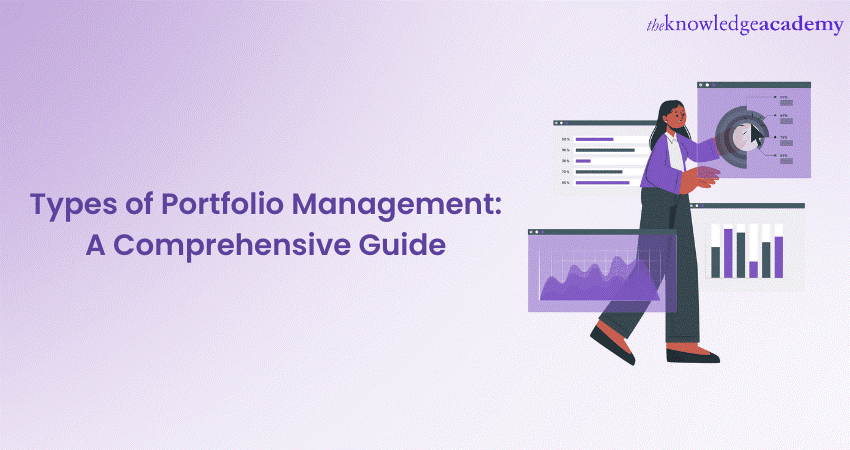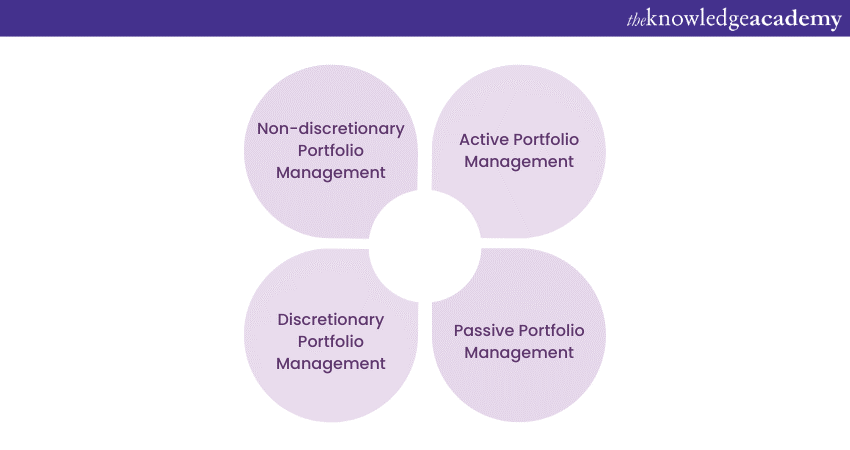We may not have the course you’re looking for. If you enquire or give us a call on 01344203999 and speak to our training experts, we may still be able to help with your training requirements.
Training Outcomes Within Your Budget!
We ensure quality, budget-alignment, and timely delivery by our expert instructors.

Investing in the financial markets requires careful planning and decision-making. The different Types of Portfolio Management play a crucial role in optimising investment returns while managing risk. By diversifying investments and employing effective strategies, Portfolio Managers aim to achieve financial goals for individuals and institutions alike. Understanding these approaches will help you make informed investment decisions whether you are just starting or experienced in investing.
In this blog, we will explore the Types of Portfolio Management and the unique characteristics exclusive to them.
Table of Contents
1) Portfolio Management – an overview
2) What are the Types of Portfolio Management?
a) Active Portfolio Management
b) Passive Portfolio Management
c) Discretionary Portfolio Management
d) Non-discretionary Portfolio Management
3) Conclusion
Portfolio Management – an overview
Portfolio Management is the effective process of managing a diverse range of investments to achieve financial objectives. It is a fundamental aspect of effective financial planning and investment and involves the strategic management of a collection of investments, known as a portfolio, to achieve specific financial goals while balancing risk and return.
Portfolio Management involves selecting, allocating, and monitoring assets within a portfolio. The key objective of a Portfolio Manager is to optimise returns while considering an investor's risk tolerance, time horizon, and investment goals.
Learn how to create effective programme, portfolio, and project management, and drive success with our comprehensive P3O Training courses!
What are the Types of Portfolio Management?
There are various Types of Portfolio Management strategies, each with its unique characteristics, objectives, and methodologies. Let's explore the most employed approaches:

Active Portfolio Management
Active Portfolio Management is a dynamic investment approach that involves making operational investment decisions with the goal of outperforming the market. It requires skilled Portfolio Managers who conduct in-depth research, analyses market trends, and actively select and manage investments in pursuit of superior returns.
Active Portfolio Management offers both advantages and disadvantages:
Pros:
a) Potential for higher returns: Skilled active managers have the potential to generate higher returns by identifying mispriced assets and taking advantage of short-term market opportunities.
b) Flexibility and adaptability: Active managers can adjust the portfolio's asset allocation, sector weightings, and individual holdings based on changing market conditions, economic outlook, and investment opportunities.
c) Opportunity to beat the market: Active managers aim to outperform the market benchmark or index, potentially allowing investors to achieve above-average returns.
Cons:
a) Higher costs: Active Portfolio Management typically involves higher costs compared to passive strategies. These costs include management fees, transaction fees, and research expenses.
b) Potential for underperformance: Active managers may fail to consistently outperform the market due to incorrect investment decisions, poor timing, or the inability to identify mispriced assets consistently.
c) Higher portfolio turnover: Active trading can result in higher portfolio turnover, leading to increased transaction costs, capital gains taxes, and potential market impact.
Passive Portfolio Management
Passive Portfolio Management, also known as index investing, is an investment approach that aims to replicate the performance of a particular market index rather than actively attempting to outperform the market. Passive managers construct portfolios that closely mirror the composition and weightings of the chosen index.
Passive Portfolio Management offers both advantages and disadvantages:
Pros:
a) Lower costs: Passive management generally involves lower costs compared to active strategies. Since passive managers aim to replicate an index, they have lower research and trading expenses. Index funds also mostly have lower expense ratios compared to actively managed funds.
b) Broad market exposure: Passive managers provide investors with exposure to an entire market or a specific sector by replicating the index. This broad market exposure allows investors to diversify their holdings across numerous securities, reducing the impact of individual stock performance on the overall portfolio.
c) Consistency and simplicity: Passive management follows a systematic and rules-based approach. Investors can expect consistent performance in line with the index, and the strategy is relatively straightforward to understand and implement.
Cons:
a) Limited potential for outperformance: Passive Portfolio Management does not aim to outperform the market index. As a result, it may miss out on potential opportunities for superior returns that active managers might capture by selecting undervalued assets or making tactical allocation decisions.
b) No risk mitigation strategies: Passive managers do not actively adjust the portfolio based on market conditions or economic forecasts. Therefore, passive portfolios may be fully exposed to market downturns without the benefit of risk management strategies employed by active managers.
c) Lack of customisation: Passive portfolios have limited flexibility for customisation. Investors must stay within the index's composition and weightings, potentially restricting their ability to align the portfolio with specific preferences or investment goals.

Discretionary Portfolio Management
Discretionary Portfolio Management is a professional investment service provided by wealth managers or Portfolio Managers who make investment decisions for their clients. In discretionary management, the portfolio manager can buy, sell, and make changes to the portfolio without obtaining explicit consent for each transaction.
Discretionary Portfolio Management offers both advantages and disadvantages:
Pros:
a) Time-saving: By delegating investment decisions to a discretionary manager, investors can save time and effort that would otherwise be required for ongoing research, monitoring, and decision-making. This allows investors to focus on other aspects of their lives while still having their investments managed professionally.
b) Tailored solutions: Discretionary managers construct portfolios based on the individual client's investment goals, risk tolerance, and preferences. This customisation ensures that the portfolio is aligned with the client's specific needs and objectives.
c) Active portfolio adjustments: Discretionary managers continuously monitor the portfolio and make timely adjustments based on market conditions and opportunities. This dynamic management approach allows for the potential to capture market upswings and mitigate risks during downturns.
Cons:
a) Loss of control: With discretionary management, investors delegate the decision-making authority to the Portfolio Manager. This means they have less direct control and involvement in the investment decisions. Some investors may feel uncomfortable relinquishing control over their investments and prefer a more hands-on approach.
b) Potential for misalignment: Despite providing an investment mandate, the discretionary manager's decisions may not always align perfectly with the investor's preferences or expectations. Differences in risk appetite, investment style, or market views can lead to a misalignment between the investor and the manager.
c) Lack of learning opportunities: For investors who enjoy being actively involved in their investment decisions, discretionary management may limit the learning opportunities that come from researching, analysing, and making investment choices independently. Some investors find value in the learning process and may prefer to retain control over their investment decisions.
Identify Portfolio Management techniques! Register for our Management Of Portfolios (MoP®) Foundation & Practitioner course now!
Non-discretionary Portfolio Management
Non-discretionary Portfolio Management is an investment approach where the Portfolio Manager provides investment advice and recommendations to clients, but the final decision-making authority rests with the clients themselves. In non-discretionary management, clients retain complete control over their investment decisions and must provide explicit consent for each transaction.
Non-discretionary Portfolio Management offers both advantages and disadvantages:
Pros:
a) Client control: Non-discretionary management allows clients to retain control over their investment decisions. Clients have the final say on whether to implement the recommendations provided by the Portfolio Manager, giving them a sense of major involvement and ownership in the investment process.
b) Personalised advice: Non-discretionary managers offer personalised investment advice tailored to the client's specific circumstances and objectives. Clients can benefit from the manager's expertise while taking their unique preferences and needs into account.
c) Educational opportunities: Non-discretionary management provides clients with learning opportunities. By working closely with the Portfolio Manager, clients can gain insights into investment strategies, market analysis, and decision-making processes. This can enhance their investment knowledge and empower them to make informed decisions.
Cons:
a) Time and effort: Non-discretionary management requires active involvement from clients. They need to dedicate effort and time to review investment recommendations, conduct research, and make decisions on their own. This can be challenging for individuals with limited time or who prefer a more hands-off approach to their investments.
b) Limited expertise: Clients who opt for non-discretionary management may have a different level of expertise than Portfolio Managers. While they receive advice and recommendations, they may need to gain the specialised knowledge and experience that professional Portfolio Managers bring. This could result in suboptimal investment decisions if clients are not well-versed in financial markets and investment analysis.
c) Emotional bias: Non-discretionary management requires clients to make investment decisions themselves, which can be influenced by emotions such as fear, greed, or overconfidence. Emotional biases can lead to suboptimal investment choices, such as buying or selling, based on short-term market fluctuations rather than long-term investment goals.
Elevate your portfolio management expertise, unlock advanced strategies, and upgrade your skills to with our specialised MOP Practitioner Upgrade training!
Conclusion
In conclusion, Portfolio Management is a vital aspect of successful investing, enabling individuals and businesses to optimise returns, manage risks, and achieve their financial goals. By understanding the different Types of Portfolio Management and their respective pros and cons, investors can make informed decisions and construct portfolios that align with their objectives and risk tolerance. Whether employing active, passive or discretionary approaches, the key is to remain consistent, periodically review the portfolio, and adapt it to changing market conditions.
Maximise strategic alignment to Portfolio Management, and achieve excellence with our Management of Portfolios (MoP) courses!
Frequently Asked Questions
Upcoming Business Skills Resources Batches & Dates
Date
 Management of Portfolios (MoP®) Foundation & Practitioner
Management of Portfolios (MoP®) Foundation & Practitioner
Mon 20th May 2024
Mon 17th Jun 2024
Mon 15th Jul 2024
Mon 12th Aug 2024
Mon 9th Sep 2024
Mon 14th Oct 2024
Mon 11th Nov 2024
Mon 9th Dec 2024







 Top Rated Course
Top Rated Course


 If you wish to make any changes to your course, please
If you wish to make any changes to your course, please


